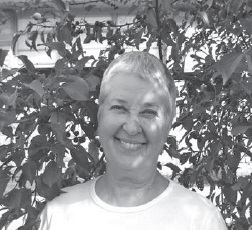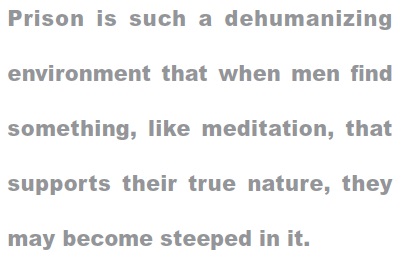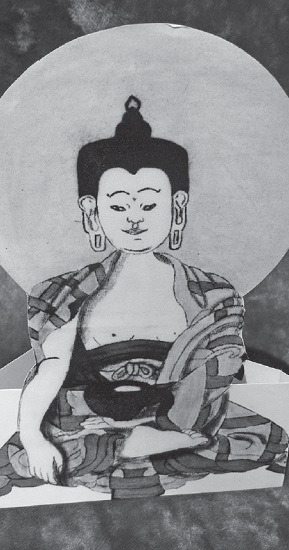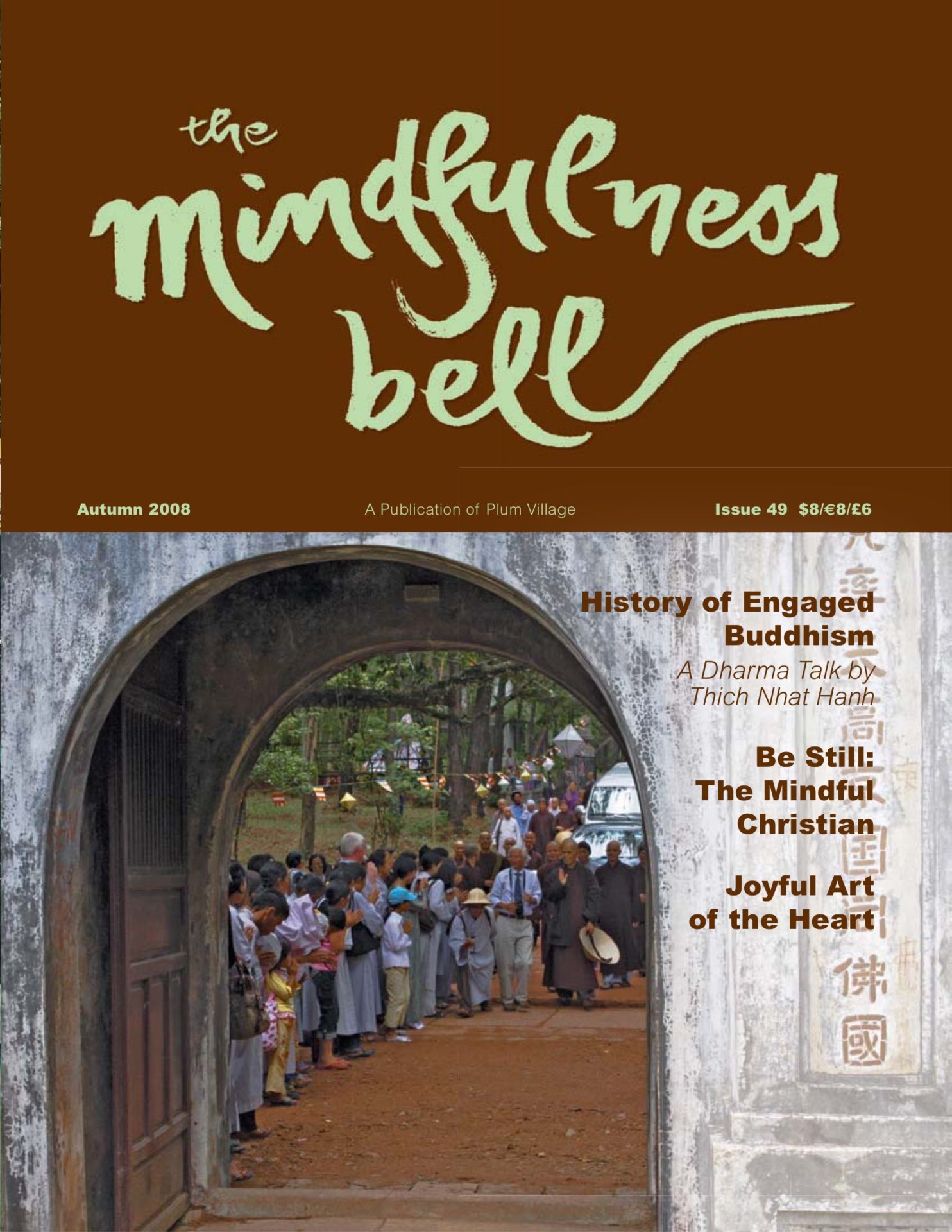
By Carole Baker
Illustration by Robert E. Walls
Five years ago one of my teachers, Anh-Huong Nguyen, said to me, “Your daily practice seems to be going well, but the Order of Interbeing is the Bodhisattva Path. If you wish to walk this path, you must spread the Dharma.” I wanted to follow this direction and it was not so easy, as I am apparently the only Buddhist living in this rural county in south central Pennsylvania.

By Carole Baker
Illustration by Robert E. Walls
Five years ago one of my teachers, Anh-Huong Nguyen, said to me, “Your daily practice seems to be going well, but the Order of Interbeing is the Bodhisattva Path. If you wish to walk this path, you must spread the Dharma.” I wanted to follow this direction and it was not so easy, as I am apparently the only Buddhist living in this rural county in south central Pennsylvania.

Three months earlier, I had been contacted by Wakeel,* a Virginia inmate who was interested in starting a Sangha at Red Onion State Prison. This contact grew into a lively correspondence exploring Buddhist philosophy. He was especially interested in the practice of being with unknowing. We decided to “spread the Dharma” by forming a paper Sangha for inmates across the country and that Sangha quickly grew to fifteen inmates in prisons in eight states. We called it Spirit Sangha because the only requirement for membership was to sit “together in spirit” every Tuesday at 7:00 pm, Eastern Time. When I sit with the Sangha, I go into the smallest room in my house. It’s six feet by nine, the same as a prison cell. I am always aware that I am free to go in and out of that room or any room in my house.
I answer letters and send an informal newsletter three or four times a year. Spirit Sangha gives inmates a connection to the outside world and a sense of belonging. As with most forms of teaching, I have learned so much from the prisoners who reach out to me for information and advice, and my practice has become more solid with the responsibility. I share with them the road bumps in my own practice and they respond with compassion and good advice based on their experiences. I couldn’t ask for a more useful way of sharing the Dharma. Sharing goes both ways.
Hell on Earth
Last year for a short time I was privileged to work directly with prisoners in two Pennsylvania prisons, Huntingdon State Correctional Institution (SCI), three mountains west of me, and Houtzdale SCI, a two-and-a-half-hour drive west of Huntingdon. They have access to only one, two-hour meditation service per month. By contrast, Catholic mass is offered daily. Buddhist services are provided at only four Pennsylvania prisons. Books and magazines are available; otherwise the prisoners are on their own in developing their personal practices. Houtzdale is a fairly modern facility with air-conditioning, but Huntingdon is something else.
Huntingdon SCI, a maximum-security prison built as a juvenile boys reformatory in 1898, is a hellhole. It is the oldest prison in continuous use in the state. Local newspaper stories regularly raise the possibility of closing Huntingdon SCI. Instead, current plans are to continue its use and build yet another facility in Huntingdon. That will make three prisons contributing to Huntingdon County’s employment rates, which routinely are among the highest in the state. The cells I saw are tiny, with no windows and iron grates as doors. The only natural light comes from tall, narrow, iron-covered windows that are at least thirty feet from the cell block, which runs down the center of the huge, three-story hall. All the walkways and staircases are cast-iron grates. The three-story climb to the chapel is dizzy-making. Constant noise bounces off the hard surfaces and echoes through the buildings, twenty-four hours a day.

It is remarkable that anyone could produce art in such an environment, let alone sacred art, such as the luminous and beautiful, gentle Buddha that is the subject of this article.
While at Huntingdon SCI, I connected with a few of the fifteen to twenty inmates who attend the monthly Buddhist meditation services. There is not much time to get acquainted, as Catholic mass immediately follows Buddhist services and the inmates hungrily rush to gather up reading material that will inform their personal practices for the next month. A woman coming into this atmosphere is something of a rarity, so my heart was touched by how polite, respectful, and even protective the men seemed to be with me.
One inmate, Carlos, asked me about tai chi, which I used to teach. When I replied that tai chi is a form of meditation, moving meditation, Carlos exclaimed, “See? I tried to tell them!” Carlos had been put in “the hole” for practicing tai chi in the exercise yard. The shared experience of tai chi practice formed a bond between this inmate and me. It is wonderful how one common experience can be a bonding agent for interbeing. Carlos and I also share concerns for our children. He suffers deeply that he cannot give his children daily support and guidance like other fathers. He offered me sound advice for dealing with my children.
Prison is such a dehumanizing environment that when men find something, like meditation, that supports their true nature, they may become steeped in it. Meeting Kevin, I was impressed with how dedicated and focused he was with regard to the Dharma. He was completely serious and earnest about his studies and his practice. His practice fills the long days. I took Kevin, and all the other men as well, with me in my heart when I left that prison.
Birth of the Cell Buddha
In July, I completed the first cohort of Buddhist Chaplaincy Training Program conducted by the New York Zen Center for Contemplative Care (zencare.org). It was a remarkably enriching experience, and quite demanding academically. One requirement was an individual, special project that manifested the student’s reflection on learning to care for others with close attention and compassion. One student made a collage, another wrote a poem. One student developed a workshop designed to train executives in leading with compassion, another wrote a manual for chaplains on ceremonies for dying patients and their friends and families at the death event.
For my special project, I chose to “spread the Dharma” by reproducing and distributing the artwork of a prisoner at Huntingdon SCI. Kevin expressed the initial idea. One morning, Kevin said to me, “Carole, the Christians get to have a picture of Jesus or Mary on their cell walls. I wish I could have a picture of the Buddha for my wall; but I really need a Buddha that I can take down and use as an altar when I meditate.” Kevin’s request stayed with me for months. Then, without very much planning, research or deep contemplation, I found a way to fulfill his need and produce a meaningful project for my chaplaincy training.

I had pored over ten years of Buddhism magazines and several commercial import websites, looking for the perfect Buddha statue to use as a “Cell Buddha.” Then Carlos did something that touched my heart. He sent me a wonderful present for Mother’s Day, an original painting of the Buddha, drawn and painted by a fellow inmate on a square of cloth, similar to a Tibetan thangka. It is special when a prisoner finds a way, with the meager resources available, to practice generosity and compassion. I cherish the beautiful, handmade greeting cards I get from inmates. They open my heart. After shedding bittersweet tears of gratitude and sadness, I keep them near my home altar.
“Snail” Mail doesn’t fully describe the pace of communicating with people in prison. What you and I can do with one e-mail exchange often takes months in communicating with prisoners. I wrote to Carlos, Carlos talked with Robert Walls, the artist who created the painting, and sent me his name and I.D. number. I wrote to Robert Walls asking permission to reproduce and distribute his artwork. I felt it was important to request permission, as prison inmates have very few empowering experiences. I complimented Robert on his artwork and told him about Kevin’s request. I told him of my desire to have the Cell Buddha sent to the Spirit Sangha and perhaps to many inmates across the country and perhaps internationally. I said, “Robert, through your art, you have the capacity to bring peace of mind and joy into the cells of thousands of prisoners.” Robert replied with the following:
Yes you have my permission. I like drawing for other people. If it brings joy to others, then I’m doing my job and it brought tears to your eyes. I am glad you like it and you put a smile on my face. Your letter inside the card you sent made me smile for the first time in 18 ½ years.
It is my fervent intention to give Robert many more smiles in the future. He may not be a Buddhist, but he has earned a special, bodhisattva membership in the Spirit Sangha.
I spent several hours reducing and copying Robert’s artwork and cutting and folding the heavy photographic paper so an inmate can stand it up to use as an altar. I made two trips to the nearest copy center in Chambersburg. The Cell Buddhas and a short newsletter giving its background went to fifteen prisoners who are members of the Spirit Sangha. I had to reduce it to fit into a #10 business envelope in order to comply with mail restrictions in Virginia. Four-inch tabs fold back from the Buddha’s knees and interlock to make a stable, triangular base.
Several inmates have written thank-you letters and commented on the little Cell Buddha, including Kevin, of course. Herb, a fellow artist at Red Onion State Prison in Virginia, wrote, “This Cell Buddha is a brilliant idea!” Kris, a student of Kadampa Tibetan Buddhism in Maryland, said, “Thank you so much for the Buddha. He is sitting at the end of my bed right now.” And Carlos, whose friendship and generosity initiated the project, wrote, “You took me by surprise when you told me I was helping to bring happiness to thousands of prisoners. It blew my mind to read that. It made me feel really good about myself.”
I encourage you to go to www.prisonDharmanetwork.org and sign up to be a pen-pal to a prisoner. They have a list of prisoners waiting for someone to regard them as human beings, waiting for interbeing, waiting for your letters. The need is so great, and the rewards are unsurpassed. There are other organizations as well that conduct prison mission work. It doesn’t take too much time; it’s safe (just rent a Post Office box); and you will never regret opening your heart in this way.
My promise to Robert is that I will offer his artwork to several Buddhist organizations that conduct prison projects in hopes that his Cell Buddha can be distributed to prisoners throughout the world. Thank you, Robert; thank you, Carlos; thank you, Thay; thank you, Buddha.
Carole Baker, Healing Joy of the Heart, lives in Shade Gap, Pennsylvania.
*Last names of inmates were deleted because prison officials might object to certain types of communication between inmates. However, the author wants Robert Walls’ name to be printed in full, so he can get credit for his artwork.

